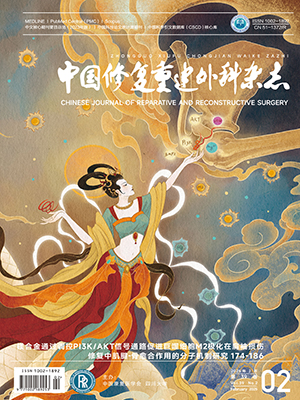| 1. |
Jones BA, Pei M. Synovium-derived stem cells:a tissue-specific stem cell for cartilage engineering and regeneration. Tissue Eng Part B Rev, 2012, 18(4):301-311.
|
| 2. |
符培亮, 张雷, 吴海山, 等. 腺病毒介导BMP-2/7共表达转染兔滑膜MSCs体外向纤维软骨样细胞分化的研究. 中国修复重建外科杂志, 2013, 27(3):345-352.
|
| 3. |
De Bari C, Dell'Accio F, Tylzanowski P, et al. Multipotent mesenchymal stem cells from adult human synovial membrane. Arthritis Rheum, 2001, 44(8):1928-1942.
|
| 4. |
赵文君, 邢国胜, 于顺禄. 滑膜间充质干细胞及其在组织工程中的应用. 中国修复重建外科杂志, 2011, 25(12):1504-1507.
|
| 5. |
Sekiya I, Colter DC, Prockop DJ. BMP-6 enhances chondrogenesis in a subpopulation of human marrow stromal cells. Biochem BiophysRes Commun, 2001, 284(2):411-418.
|
| 6. |
Sekiya I, Larson BL, Vuoristo JT, et al. Comparison of effect of BMP-2,-4, and-6 on in vitro cartilage formation of human adult stem cells from bone marrow stroma. Cell Tissue Res, 2005, 320(2):269-276.
|
| 7. |
Nishimura K, Solchaga LA, Caplan AI, et al. Chondroprogenitor cells of synovial tissue. Arthritis Rheum, 1999, 42(12):2631-2637.
|
| 8. |
Eslaminejad MB, Karimi N, Shahhoseini M. Chondrogenic differentiation of human bone marrow-derived mesenchymal stem cells treated by GSK-3 inhibitors. Histochem Cell Biol, 2013.[Epub ahead of print].
|
| 9. |
Tapp H, Deepe R, Ingram JA, et al. Adipose-derived mesenchymal stem cells from the sand rat:transforming growth factor beta and 3D co-culture with human disc cells stimulate proteoglycan and collagen type I rich extracellular matrix. Arthritis Res Ther, 2008, 10(4):R89.
|
| 10. |
Shirasawa S, Sekiya I, Sakaguchi Y, et al. In vitro chondrogenesis of human synovium-derived mesenchymal stem cells:optimal condition and comparison with bone marrow-derived cells. J Cell Biochem, 2006, 97(1):84-97.
|
| 11. |
Pei M, Zhang Y, Li J, et al. Antioxidation of decellularized stem cell matrix promotes human synovium-derived stem cell-based chondrogenesis. Stem Cells Dev, 2013, 22(6):889-900.
|
| 12. |
Diaz-Flores L Jr, Gutierrez R, Madrid JF, et al. Cell sources for cartilage repair; contribution of the mesenchymal perivascular niche. Front Biosci (Schol Ed), 2012, 4:1275-1294.
|
| 13. |
芮云峰, 王友. 人滑膜间充质干细胞的研究现状. 中华关节外科杂志(电子版), 2007, 1(1):60-62.
|
| 14. |
Sekiya I, Vuoristo JT, Larson BL, et al. In vitro cartilage formation by human adult stem cells from bone marrow stroma defines the sequence of cellular and molecular events during chondrogenesis. Proc Natl Acad Sci U S A, 2002, 99(7):4397-4402.
|
| 15. |
Rui YF, Du L, Wang Y, et al. Bone morphogenetic protein 2 promotes transforming growth factor beta3-induced chondrogenesis of human osteoarthritic synovium-derived stem cells. Chin Med J (Engl), 2010, 123(21):3040-3048.
|
| 16. |
Sher L, Oquendo MA, Burke AK, et al. Combined dexamethasone suppression-corticotrophin-releasing hormone stimulation test in medication-free major depression and healthy volunteers. J Affect Disord, 2013.[Epub ahead of print].
|
| 17. |
Barry F, Boynton RE, Liu B, et al. Chondrogenic differentiation of mesenchymal stem cells from bone marrow:differentiation-dependent gene expression of matrix components. Exp Cell Res, 2001, 268(2):189-200.
|
| 18. |
Jin G, Westphalen CB, Hayakawa Y, et al. Progastrin stimulates colonic cell proliferation via CCKBR-and beta-arrestin-dependent suppression of BMP2. Gastroenterology, 2013, 145(1):820-830.
|
| 19. |
Li J, Wang J, Zou Y, et al. The influence of delayed compressive stress on TGF-β1-induced chondrogenic differentiation of rat BMSCs through Smad-dependent and Smad-independent pathways. Biomaterials, 2012, 33(33):8395-8405.
|
| 20. |
邱林, 金先庆, 罗小辑, 等. 转化生长因子β3基因转染兔骨髓间充质干细胞的实验研究. 中国修复重建外科杂志, 2006, 20(9):940-943.
|
| 21. |
Chang MT, Cheng YS, Huang MC. A novel non-synonymous SNP of the COLX gene and its association with duck reproductive traits. Mol Cell Probes, 2012, 26(5):204-207.
|
| 22. |
Mwale F, Stachura D, Roughley P, et al. Limitations of using aggrecan and type X collagen as markers of chondrogenesis in mesenchymal stem cell differentiation. J Orthop Res, 2006, 24(8):1791-1798.
|
| 23. |
Shen B, Wei A, Tao H, et al. BMP-2 enhances TGF-beta3-mediated chondrogenic differentiation of human bone marrow multipotent mesenchymal stromal cells in alginate bead culture. Tissue Eng Part A, 2009, 15(6):1311-1320.
|
| 24. |
Horie M, Sekiya I, Muneta T, et al. Intra-articular injected synovial stem cells differentiate into meniscal cells directly and promote meniscal regeneration without mobilization to distant organs in rat massive meniscal defect. Stem Cells, 2009, 27(4):878-887.
|




